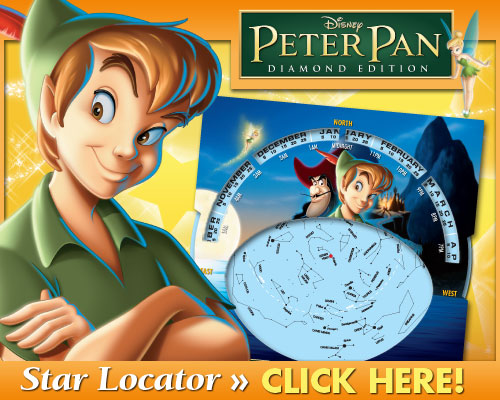Does your family believe in magic, fairies, Never Land? The feature below takes a look at whether there might be a real Never Land out there! In celebration of today's 60th Anniversary release of Peter Pan we're providing printable Star Gazing Locator Tools to help your family look at the constellations in the night sky to figure out where you think Never Land might exist!
Peter Pan Diamond Edition is now available on Blu-ray/DVD Combo Pack!
Is There a Real Never Land?
By Harrison J. Pierce
Since it first debuted in theaters in 1953, Walt Disney Studio’s animated classic Peter Pan has long captured the imaginations of children and adults around the world with its tale of an enchanted place where fairies, Lost Boys, mermaids and pirates live and adventures never cease. But what if somewhere beyond our world such a place actually exists? Peter Pan says it's "past the second star to the right and straight onto morning," but is Never Land real?
Before the advent of modern space science and technology, most Earth-dwellers assumed outer space was just a wasteland of stars. But astronomers are learning that the night sky isn’t just full of stars; it’s full of planets.
One team from the California Institute of Technology in Pasadena recently made a new estimate of the numbers of planets in our galaxy and came up with a whopping 100 billion. The team made this exciting discovery using NASA's Kepler space telescope to look at class of red stars called “M dwarfs,” which are the most common stars found in the Milky Way. The study suggests, in fact, that for every star there is, on average, a corresponding planet. With an estimated 100 billions stars in the sky, that’s a whole lot of planets. Could Never Land lie around one of these stars?
Another study, led by researchers at the Harvard Smithsonian Center for Astrophysics in Cambridge, Mass., used Kepler data to estimate the number of Earth-size planets orbiting other stars. They found that an estimated 17 percent of stars have Earth-size planets in orbits closer than Mercury is to the sun. When they looked at orbits at about the distance of Earth, the number of stars with Earth-size planets is at least 70 percent.
Of course, not all planets in the galaxy are habitable. Just as some planets in our solar system fly too close or too far from the sun to be inhabited, only the planets orbiting at the right distance from their stars are considered “temperate,” meaning they’re the right temperature for liquid water, an essential element for sustaining human life and, of course, keeping mermaids and sea-faring pirates afloat.
The Kepler space telescope continues to hunt for those "just right" planets -- Earth-size worlds that orbit in the habitable zones of stars like our sun.
But until our planet’s top space scientists find a way for us to travel safely in search of a real life Never Land, Disney invites us to rediscover their wondrous animated version of it on February 5th, when Peter Pan soars onto Diamond Edition Blu-ray™ and DVD.


0 comments :
Post a Comment